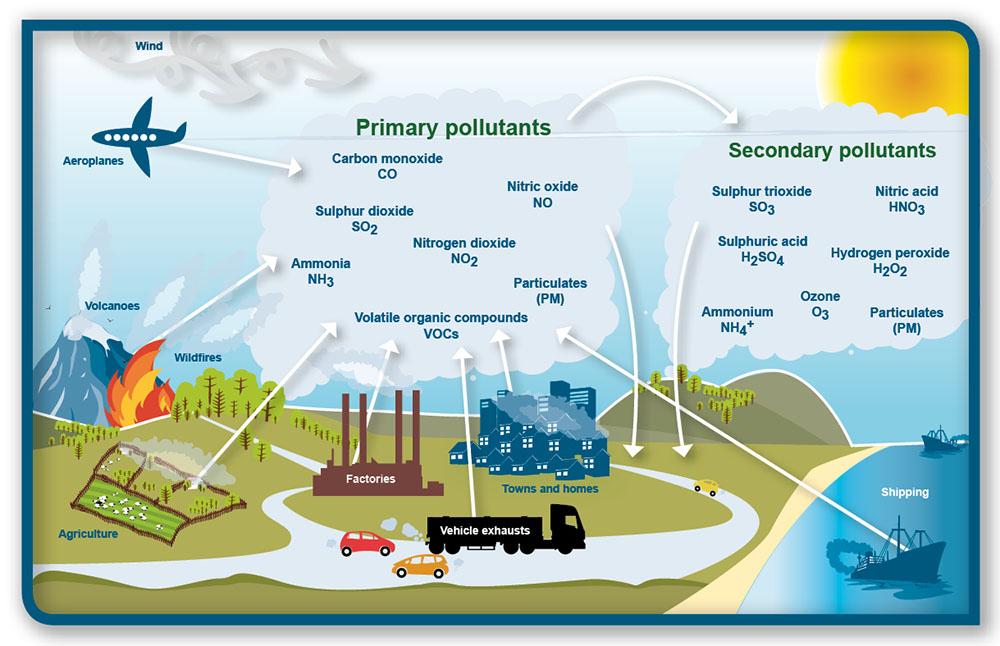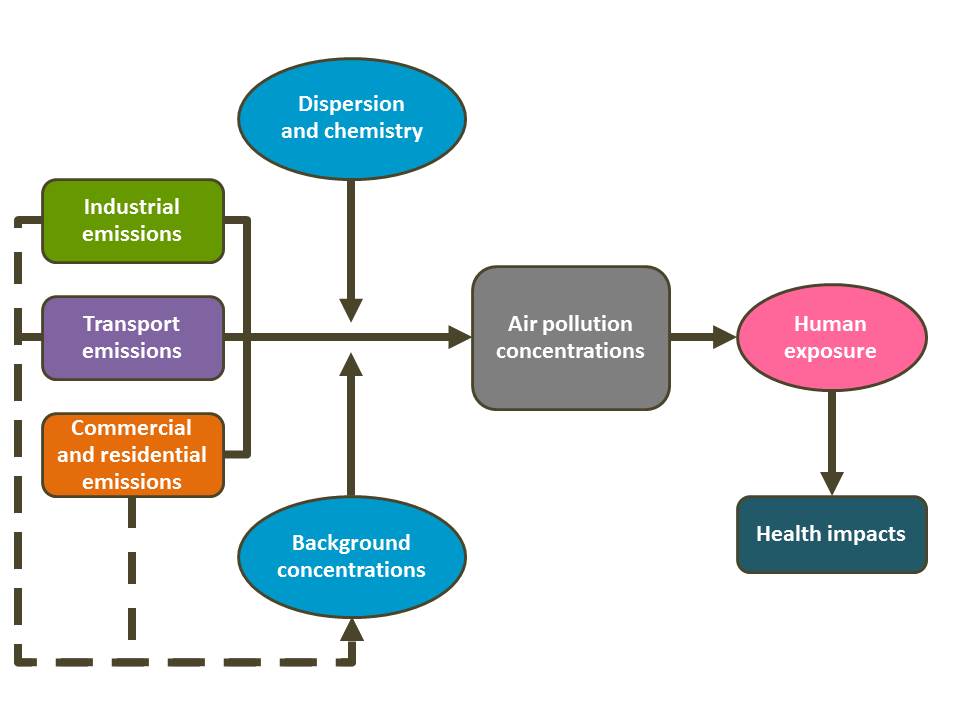The quality of air around us is affected by substances released into the atmosphere through human activities, such as transport and industry, as well as from natural sources such as sea salt and volcanic activity.
Key messages
- Air quality has improved significantly since the 1950s, with dramatic reductions in most pollutants, in particular lead, carbon monoxide and sulphur dioxide.
- However, air pollution still damages our health and the environment. It is caused by emissions from industry, transport, energy and agriculture, as well as some household activities, such as heating and cooking.
- Watch, look and listen - Air - Making the case video. YouTube: Making the case for the environment: Air quality
Sources of air pollution - Clean air for Scotland
Relationships between Air Quality emissions and concentrations (Clean Air For Scotland Strategy)
- A number of pollutants are continuously measured across a range of urban and rural locations throughout Scotland. Where air quality standards and objectives are not being met, local authorities set up Air Quality Management Areas (AQMAs). As monitoring and assessment activities in Scotland increase, more AQMAs have been identified and declared.
- Watch, look and listen - How we monitor air quality video.
- Although there are a number of policy and legislative measures in place aimed at reducing air pollution, wider measures will need to be considered to achieve further reductions.
Data
Changes in emissions to air in Scotland
View data using the UK Air Quality Tool
Air quality and government standards
View the Air quality standards and objectives
Find out more information about Air quality and health
What are we doing?
Air quality and citizen science
Learning about air
The learn about air teaching package contains interactive teaching material, classroom activities and lab experiments to make learning about air quality fun. Packages are tailored for primary schools and secondary school Geography and Science, bringing in an element of citizen science to the pupils by encouraging then to monitor air quality around their schools using low-cost air pollution sensors.
Case study on changing behaviours to improve air quality. SEPA, in partnership with North Lanarkshire Council and Education Scotland, has developed an air quality teaching package, based around the Curriculum for Excellence, in the form of a dedicated website learn about air.
Primary schools and secondary schools can view data collected by air quality sensors to monitor pollutants outside of their school. The secondary school travel application allows students to visualise travel survey data they collect in the learn about air secondary school package. It allows pupils to see the air quality ‘footprint’ of their classes journey to school and see how they compare to other schools across Scotland. The virtual city application helps students consider how different travel choices and fuel types can affect their air quality and how future choices can improve poor air quality areas.
Transport
Transport is the most significant source contributing to poor air quality in urban areas. Although emissions from transport have declined over the years, the rate of decline has started to level off. So without additional measures to tackle transport-related pollution, it is possible that emissions will begin to increase again. These measures include:
- Central and local government commitment to de-carbonise the transport fleet by 2050
- Low Emission Zones
- congestion charges
- vehicles that run on alternative fuel
- initiatives to encourage reduced numbers of journeys and a shift from private to public transport.
- compliance with air pollution legislation and the benefits of keeping air pollution to a minimum (see the NetRegs online guide where some actions can actually save you money or have added benefits to greenhouse gas emissions)
Industry
Considerable progress has been made over recent decades in controlling emissions from industrial sources. Robust legislation and stringent operating conditions, combined with technological developments and decline in heavy/manufacturing industry, have significantly reduced national emissions. Further developments in technology and legislation will continue to drive down emissions.
Policy and legislation
Europe
In Europe more people die as a result of poor air quality than in road traffic accidents. It is the main cause of preventable illness and premature death in the EU from an environmental source. Poor air quality also affects the environment, so, the European Union (EU) has adopted a series of legislative measures to reduce air pollution.
There are two main pieces of EU legislation dealing with air pollution:
- Directive on ambient air quality and cleaner air for Europe, which sets EU air quality standards for particulate matter (PM), nitrogen oxides, sulphur dioxide, heavy metals and a number of other pollutants.
- National Emission Ceilings Directive (NECD), which sets emission limits for sulphur dioxide, nitrogen oxides, ammonia and volatile organic compounds (VOCs), reducing national emissions to meet international agreements.
The European Commission reviewed the EU’s air quality policy and legislation, and in 2013 a revised Clean air policy package for Europe was published. The main components of the package are:
- a Clean air programme for Europe which includes measures to ensure that existing ambient air quality targets are met by 2020, and new air quality objectives to bring down pollution emissions by 2030
- a revised NECD with stricter national targets for the main pollutants and new pollutants included
- a proposed directive to reduce pollution from medium-scale combustion activities.
UK
The UK’s Air Quality Strategy for England, Scotland, Wales and Northern Ireland was developed to improve air quality in the UK, to protect our health and the environment. It sets UK standards and objectives for reducing a series of pollutants. For some pollutants Scotland has adopted more stringent objectives than the rest of the UK. The strategy sets out the UK’s system for Local Air Quality Management (LAQM). The LAQM system has recently been reviewed and the revised system and accompanying guidance released during 2016.
Scotland
Cleaner Air for Scotland (CAFS)
Find out about the national approach Scotland is taking to tackle air pollution and achieve Cleaner air for Scotland.
Scotland has recently introduced legislation to implement WHO guidelines for PM2.5.
Local authorities
Local authorities must:
- Review and assess a range of pollutants that are set out within the Air Quality Strategy
- declare as Air Quality Management Areas (AQMAs) any areas where standards are not being (or not likely to be) met
- and put in place an air quality action plan to reduce pollution levels.
At present, 14 local authorities in the most densely populated areas of Scotland have declared AQMAs. The number of areas declared has increased from 26 in 2011 to 34 in 2016 and it is expected that this number may continue to rise in the future. Most AQMAs have been declared due to emissions from traffic.
This page was reviewed on 11 Apr 2017
Adobe Acrobat Reader is the free, trusted leader for reliably viewing, annotating and signing PDFs.
Download Adobe Acrobat Reader


